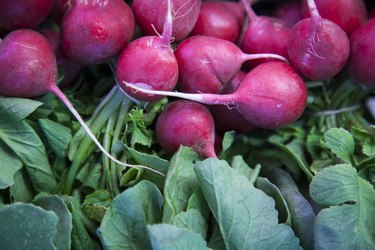
The turnip (Brassica rapa L.) is a widely grown root vegetable and used for centuries as a livestock forage crop, as well as for human consumption. Turnip leaves are also harvested as greens for the kitchen. This biennial member of the mustard family prefers loose, well aerated and fertile soil and will overwinter in U.S. Department of Agriculture plant hardiness zones 8 through 10. Occasionally, a turnip crop will suffer from some form of leaf yellowing. This yellowing could be caused by a number of factors, ranging from a nutritional deficiency to a fungal infection.
Tip
Turnip leaves may turn yellow due to deficiencies in nutrients and/or micronutrients or diseases.
Video of the Day
Manganese Deficiency and Turnip Leaves
Turnips and related vegetables are susceptible to a manganese deficiency. This type of deficiency is indicated by a general yellowing of foliage that first appears in the middle of the growing season. A manganese deficiency is most commonly a problem in alkaline soils and can be addressed with two foliar applications of manganese sulfate spaced about a week apart. Other members of the brassica family (Brassicaceae) may suffer from similar nutritional deficiencies, resulting in broccoli and cauliflower leaves turning yellow.
Video of the Day
Black Rot Bacteria
Black rot, caused by the bacteria Xanthomonas campestris, can cause extreme loss of a turnip crop. The bacteria, which is spread by infected seed, debris and splashing water, spreads most rapidly during periods of warm, wet weather. Black rot is easily identified on turnip green leaves by the appearance of yellow V-shaped lesions that eventually dry to brown while veins become black. Avoid black rot by using certified seed and rotating to noncruciferous crops for at least three years.
Turnip Mosaic Virus
Turnip mosaic virus, which is spread by aphids, may occasionally impact turnip and rutabaga yields. Infected young leaves develop a green and yellow mosaic pattern; mature leaves turn yellow and drop. Infected plants and nearby weeds that may carry the virus should be destroyed to reduce the possibility of future viral infections.
Prevent aphid infestations by using a blast of water to knock the sap sucking insects from the leaves and controlling ants, which carry the aphids from plant to plant in order to harvest the honeydew the tiny pests produce.
Fungal Leaf Spots
Downy mildew, caused by the fungus Peronospora parasitica, and white spot (Pseudocercosporella capsellae) cause leaf yellowing in addition to other, more indicative symptoms. Leaves infected by downy mildew demonstrate a faint yellowing on the upper leaf surface while grayish-white fluffy mold spots form on the lower leaf surface. White spot causes circular spots with white, gray or brown centers before foliage turns yellow and drops. These fungi favor cool, wet conditions and are best controlled using proper crop rotation practices, improving drainage and avoiding overhead irrigation.
Root-knot Nematodes
Root-knot, caused by different species of nematodes (Meloidogyne spp.), forces plants to become pale green to yellow, suffer from stunted growth and develop swollen galls on roots, which is characteristic of these microscopic roundworms feeding. Nematodes are most prevalent during the summer in sandy, well drained soils. Address nematode problems by rotating turnips and other brassicas with non-cruciferous or grass crops.